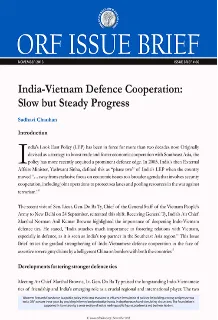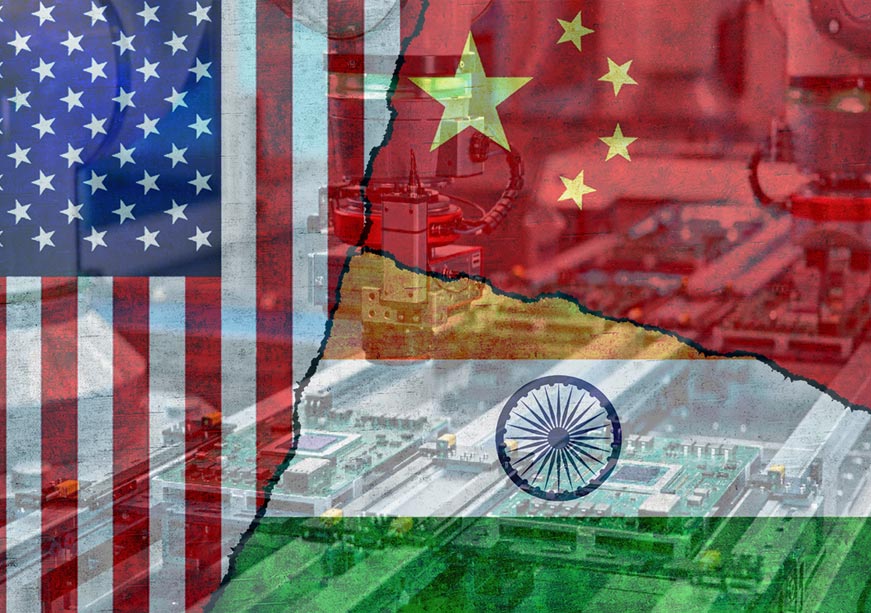Introduction
Developments fostering stronger defence ties
Meeting Air Chief Marshal Browne, Lt. Gen. Do Ba Ty praised the longstanding Indo-Vietnamese ties of friendship and India's emerging role as a crucial regional and international player. The two officials also expressed hope for a further strengthening of defence ties and agreed to promote delegation exchange, deputy minister-level defence dialogue, training, and naval and air force cooperation.
During the visit, Lt. Gen. Ty also met some other senior Indian military officials, including Defence Secretary R. K. Mathur and Integrated Defence Staff Chief Lt. Gen. Anil Chait.
General Ty's visit to India follows the 15th India-Vietnam Joint Commission meeting in New Delhi where Vietnam's Foreign Minister Pham Binh Minh highlighted the relevance of strengthening Vietnam-India bilateral bonds for peace and prosperity in the Indo-Pacific.
He stated, “The nexus between India's Look East Policy and Vietnam's foreign policy of overall international integration provides much space for us to work together. We must also pool our efforts to translate the huge potential in bilateral cooperation into reality, so that our partnership stands on a firmer ground.”3
India's Minister of External Affairs Salman Khurshid displayed consensus with his Vietnamese counterpart and stated, “Our security and defence cooperation is robust and growing because we have shared common interest and convergence in security perceptions.” The Minister also informed the press that he has extended an invitation to Vietnam's Minister of Defence to visit India later this year, in the hope that increased consultation between the two countries will help them strengthen security collaboration.4
The unresolved South China Sea dispute was identified as a crucial challenge to the security interests of both the countries during the meeting. Khurshid, while addressing this issue, noted: “Our position is that we need to respect the international law, UNCLOS, to solve the issue in South China Sea ... We also reaffirmed all the rights of the countries to have the rights in the exclusive economic zone. So, all the blocks that India has exploitation and exploration basins in, are well within the exclusive economic zone of Vietnam.”5 The Minister's statement highlighted the overlap in India and Vietnam's official stand on the issue of exploration rights in the South China Sea.6
An important development during the meeting was New Delhi's offer of USD 100 million credit line to Vietnam for defence procurement from India. This is likely to be finalised during the visit of General Secretary of the Communist Party of Vietnam to India later this year.
Notably, recent shared security concerns reinforce the longstanding Indo-Vietnamese defence ties. The two countries signed a Memorandum of Understanding (MoU) on Defence Cooperation in 1994 during the visit of then Prime Minister P.V. Narasimha Rao to Hanoi. Although this MOU was limited to training and servicing of hardware,7 it was extremely crucial as it made Vietnam one of the first countries in the Southeast Asian region to enter into an official defence agreement with New Delhi.
Indo-Vietnamese defence and security ties have made significant progress and cover several areas, including high-level military exchanges, military training, and joint exercises. In March 2000, when the then Defence Minister George Fernandes travelled to Hanoi, both the countries signed a comprehensive agreement for defence cooperation. This agreement was more encompassing and included an institutionalized framework for regular discussions between the two Defence Ministers.8
In July 2007, a new level of security cooperation was reached when the two countries concluded a strategic partnership and signed a joint declaration that “welcomed the steady development of bilateral defence and security ties” and “pledged themselves to strengthen cooperation in defence supplies, joint projects, training cooperation and intelligence exchanges”.9
The next crucial step came with India's participation in the inaugural meeting of the ASEAN Defence Ministers Meeting - Plus (ADMM-Plus) held in Hanoi in October 2010. Represented by Defence Minister A. K. Antony, India participated in the highest ministerial defence and security consultative and cooperative mechanism for regional security issues.10Meeting Prime Minister Nguyen Tan Dung on the side-lines of ADMM, India's Defence Minister promised all support to Vietnam to upgrade the capabilities of its armed forces.11
Already involved in various bilateral and multilateral security arrangements, the two countries further deepened security cooperation in 2011, with China confronting them in the South China Sea. In May of that year, Vietnam's Foreign Ministry's spokesperson reported that three Chinese marine surveillance vessels had cut surveying cables of Binh Minh 02, a surveying ship of the Vietnam National Oil and Gas Group, some 116 nautical miles off Dai Lanh cape and about 340 nautical miles off China's Hainan island coast.12 Again in June, a Chinese fishing boat rammed the survey cables of another Vietnamese survey vessel.13
Notably, these confrontations were shortly followed by the visit of Vietnam's Naval Chief and Deputy Defence Minister Vice-Admiral Nguyen Van Hien to India in June 2011.14 According to speculation prior to this visit, Hanoi had permitted Indian naval ships to berth at Nha Trang Port, which is just south of China's new naval base at Sanya in Hainan Island.15 It was also reported that during his visit to India, the Vietnamese Naval Chief visited Indian naval dockyards in Mumbai and Vishakhapatnam and conducted meetings on securing Indian help for augmenting the size and capabilities of the Vietnamese Navy.16
While there is no official evidence of India accepting berth rights at the Nha Trang port, the following month saw a friendly visit by the Indian Naval vessel—INS Airavat—to the port on 19 July. Notably on 22 July, while INS Airavat sailed from Nha Trang towards Hai Phong, and was at a distance of 45 nautical miles from the Vietnamese coast in the South China Sea, a caller identifying himself as the “Chinese Navy” contacted it on open radio channel. Official reports state that the caller warned the Indian vessel that it was, “entering Chinese waters”. Although India's Ministry of External Affairs downplayed the incident and reported that, “there was no confrontation involving the INS Airavat”,17 the incident received immense media attention in India.
Not surprisingly, when the Vietnamese President Truong Tan Sang visited India in October 2011, the two countries stressed the importance of maintaining peace, stability, and of ensuring the safety, security and freedom of navigation in the high seas. Additionally, despite pressure from Beijing,18 they also inked an agreement to promote oil exploration19 in South China Sea.20
China evidently did not receive these developments well. Jiang Yu, a spokesperson for the Chinese Foreign Ministry was quoted as stating, “…as for oil and gas exploration…we are opposed to any country engaged in the waters under China's jurisdiction. We hope foreign countries do not get involved in the South China Sea dispute.”21 Following this statement in June 2012, state-owned China National Offshore Oil Company (CNOOC), opened nine blocks for exploration in waters also claimed by Vietnam. This also included oil block 128, which has been offered by Vietnam to India's ONGC Videsh Limited (OVL) for exploration.
In the backdrop of these developments the statement by the Indian Chief of Naval Staff D.K. Joshi asserting that although India was not a claimant in the dispute over territorial rights in the South China Sea it was prepared to act if necessary to protect its maritime and economic interests in the region,22 came as a crucial indication of India's involvement in the region.
Factors driving security cooperation
Unable to resist China's unrelenting aggression from the north, Vietnam has been increasing its defence cooperation with multiple regional players including India.23 India, although not a claimant in the South China Sea dispute, is interested in the stability of the region given its proximity to it. Establishing this, Professor S D Muni has stated, “South China Sea may look far off from the Indian mainland but it is not really so when India's territorial foot prints in the western Indian Ocean, in the form of Andaman and Nicobar Islands, are kept in view”.24
Besides geopolitics, the two countries also have high economic stakes in the region that explain their security cooperation. Nearly 55 per cent of India's trade transits through the South China Sea.25 Therefore, for India the South China Sea region serves as a strategic link between the Pacific and the Indian Oceans whose security is vital for the smooth flow of its seaborne trade.
Additionally, both countries hold common interest in the exploration of the region's vital energy resources.26 India's OVL currently holds two assets in Vietnam. Block 06.1 is a producing asset and block 128 is an exploratory asset. More importantly, OVL has invested an amount of US$ 342.78 million for development of block 06.1.27
Further, India's energy requirement is continuing to grow. According to projections, by 2020 India's oil consumption is expected to rise to 245 million tonnes annually, with the country likely to be the world's single largest importer of oil by 2050.
Vietnam also continues to be an attractive investment destination for Indian companies. In 2011- 2012, India's investments in the country totalled to 750 million USD.28 Evidently, therefore, India and Vietnam have high stakes in the stability of the region.
Limitations to bilateral security cooperation
It is worth noting that despite having strong ties and common concerns in the form of long-pending territorial disputes with China, both New Delhi and Hanoi have been careful not to offend Beijing. Indian strategist C Raja Mohan has stated, “An acute sensitivity to the changing balance of power in Asia guides the current Vietnamese strategy of befriending the US and Japan, and intensifying security cooperation with India without antagonising China.”29 A number of factors explain this outlook.
First, China has emerged as a crucial economic partner for both the countries. In 2012, China was Vietnam's largest trade partner with bilateral trade amounting to 41.18 billion USD.30 Although in the same year India's bilateral trade with China fell by 12 per cent, the country still continues to be New Delhi's second largest trading partner.31
Second, India's policy in the Asia-Pacific has caused it to be categorised as a “swing state”32 which is keen on balancing its ties both with the US and China. This policy of India becomes apparent when one notes the conciliatory tone of the Indian government's response to cases involving confrontation with China in the South China Sea.33
Finally, despite having serious security interests in the region, the Indian Navy continues to get the lowest share in India's national defence budget. In the 2013-2014 defence budget,34 the Navy's share of total defence spending fell the most (1.4 per cent), and it represented the smallest share of the budget (18 per cent–versus 28 per cent for the Indian Air Force and 49 per cent for the Indian Army). Moreover, a 2010 report by India's Comptroller and Auditor General (CAG) found that the Indian Navy only has "61, 44 and 20 per cent, respectively, of the frigates, destroyers and corvettes that it has projected as its minimum requirement."35 This limits India's security cooperation with South China Sea's littorals including Vietnam.
As India undertakes “phase two” of its Look East Policy, Vietnam too is looking to proactively take part in international integration. Given the complementarity of Indo-Vietnamese security interests, strengthening defence cooperation between the two does not come as a surprise. With the frequent flaring up of tensions by China along the disputed Line of Actual Control with India, and its increasing influence in India's neighbourhood, New Delhi may swing closer towards Hanoi to further deepen security cooperation.
Endnotes:
1. C Raja Mohan, “Look East policy: phase two”, The Hindu, 9 October 2003, Available at: http://www.hindu.com/2003/10/09/stories/2003100901571000.htm
2. “India boosts defence cooperation with Vietnam”, VietnamPlus, 24 September 2013, Available at: http://en.vietnamplus.vn/Home/India-boosts-defence-cooperation-with-Vietnam/20139/39302.vnplus
3. “FM spotlights Vietnam-India bonds for peace”, VietnamPlus, 12 July 2013, Available at: http://en.vietnamplus.vn/Home/FM-spotlights-VietnamIndia-bonds-for-peace/20137/36665.vnplus
4. “Transcript of Joint Media Interaction by External Affairs Minister and Foreign Minister of Vietnam”, Ministry of External Affairs, Government of India, 11 July 2013, Available at: http://www.mea.gov.in/incoming-visit- detail.htm?21938/Transcript+of+Joint+Media+Interaction+by+External+Affairs+Minister+and+Foreign
+Minister+of+Vietnam+July+11+2013
5. ibid.
6. “Report on Viet Nam's implementation of the 1982 United Nations Convention on the Law of the Sea as a responsible party of the Convention”, Ministry of Foreign Affairs, Vietnam, Available at: http://www.mofa.gov.vn/en/nr040807104143/nr040807105001/ns121212104806/view
7. Ian Storey and Carlyle A Thayer, “Cam Ranh Bay: Past imperfect, Future Conditional”, Contemporary Southeast Asia, Vol. 23, no. 3 (December 2001) , pp. 467
8. S.D. Muni, “ The Turbulent South China Sea Waters: India, Vietnam and China, Institute of South Asian Studies,
11 October 2011, Available at: http://www.isas.nus.edu.sg/Attachments/PublisherAttachment/ ISAS_Insights_140_-_The_Turbulent_South-China_Sea_Waters_13102011121226.pdf
9. “Viet Nam, India issue joint declaration on strategic partnership”, Ministry of Foreign Affairs, Government of Vietnam, Available at: http://www.mofa.gov.vn/en/nr040807104143/nr040807105001/ ns070709091229/view
10. “Hanoi joint declaration on the first ADMM+ issued”, VietnamPlus, 12 October 2010, Available at: http://en.vietnamplus.vn/Home/Hanoi-joint-declaration-on-the-first-ADMM-issued/201010/ 12984.vnplus
11. “PM receives Indian, RoK defence ministers, Ministry of Foreign Affairs”, Government of Vietnam, Available at: http://www.mofa.gov.vn/en/nr040807104143/nr040807105001/ns101014104812/view
12. “Press Conference on Chinese maritime surveillance vessel's cutting exploration cable of PetroViet Nam Seismic Vessel”, Ministry of Foreign Affairs, Government of Vietnam, Available at: http://www.mofa.gov.vn/en/tt_baochi/pbnfn/ns110530220030/view
13. “Viet Nam lawyers oppose China's sovereignty violation”, Ministry of Foreign Affairs, Government of Vietnam, Available at: http://www.mofa.gov.vn/en/nr040807104143/nr040807105001/ ns110613095405/view
14. Annual Report 2011-12, Ministry of Defence, Government of India, Available at: http://ddpmod.gov.in/WriteReadData/l892s/2357977918AnnualReport11-12.pdf
15. Saurav Jha, “Vietnam, India Boost Naval Ties to Counter China”, World Politics Review, 29 July 2013
16. G. Parthasarathy, “ Dealing with Chinese aggression”, The Hindu Business Line, 21 July 2011, Available at: http://www.thehindubusinessline.com/opinion/columns/g-parthasarathy/dealing-with-chinese- aggression/article2277283.ece
17. “Incident involving INS Airavat in South China Sea”, Ministry of External Affairs, Government of India, 1 September 2011, Available at: http://www.mea.gov. in/media- briefings. htm? dtl/3040/ Incident+involving+INS+Airavat+in+South+China+Sea
18. China issued a demarche to India in November 2011, underlining that Beijing's permission should be sought for exploration in Blocks 127 and 128 and, without it, OVL's activities would be considered illegal.
1. “Joint Statement on the occasion of the visit of the President of Vietnam”, Ministry of External Affairs, Government of India, 12 October 2011, Available at: http://mea.gov.in/bilateral-documents.htm?dtl/ 5341/Joint+Statement+on+the+occasion+of+the+visit+of+the+President+of+Vietnam
2. Indian petroleum company ONGC Videsh Ltd. (OVL), the global arm of Oil and Natural Gas Corporation (ONGC), has stakes in hydrocarbon exploration blocks with Vietnam. The company's engagement with Vietnam dates back to 1988 when it acquired its first overseas asset, Block 06.1. OVL then acquired block 127 and 128 for exploration in 2006.
3. “India makes waves with South China Sea oil and gas exploration”, People's Daily Online, 18 September 2011, Available at: http://english.peopledaily.com.cn/90883/7598163.html
4. “Indian navy prepared to deploy to South China Sea to protect oil interests”, Reuters, 3 December 2012, Available at: http://in.reuters.com/article/2012/12/03/us-china-sea-india-idUSBRE8B20KY20121203
5. Natalie Liu, “Vietnamese President Seeks New Relationship With US”, Voice of America, 25 July 2013. Available at: http://m.voanews.com/a/1709661.html
6. S.D. Muni, Pp. 9
7. Chietigj Bajpaee, “Reaffirming India's South China Sea Credentials”, The Diplomat, 14 August 2013, Available at: http://thediplomat.com/2013/08/14/reaffirming-indias-south-china-sea-credentials/
8. According to U.S. Energy Information estimates, the South China Sea is estimated to have approximately 11 billion barrels (bbl) of oil reserves and 190 trillion cubic feet (Tcf) of natural gas reserves.
9. ONGC Annual Report 2012-2013
10. Indian Ministry of External Affairs Annual Report 2011-12, Available at: http://www.mea.gov.in/ Uploads/PublicationDocs/19337_annual-report-2011-2012.pdf
11. C Raja Mohan, “The importance of being Vietnam” Indian Express, 9 July 2007, Available at: http://www.indianexpress.com/news/the-importance-of-being-vietnam-/204292/0.
12. “Vietnamese media hails president's 1st state visit to China”, People's Daily Online, 21 June 2013, Available at: http://english.peopledaily.com.cn/90883/8294769.html
13. Government of India, Ministry of Commerce & Industry database
14. C Raja Mohan, “India and the Balance of power”, Foreign Affairs, 2006, Available at: http://www.foreignaffairs.com/articles/61729/c-raja-mohan/india-and-the-balance-of-power
15. 2011 INS Airavat incident and in 2012 Indian government downplaying Indian Chief of Naval Staff D K Joshi's statement on India being ready to protect its commercial interests in the South China Sea.
16. Laxman K Behera, “India's Defence Budget 2013-14: A Bumpy Road Ahead, IDSA Comment, IDSA, 4 March 2013, Available at: http://www.idsa.in/idsacomments/IndiasDefenceBudget2013-14_lkbehera_040313
Shashank Joshi, “Can India Blockade China?”, The Diplomat, 12 August 2013, Available at: http://thediplomat.com/flashpoints-blog/2013/08/12/can-india-blockade-china/
The views expressed above belong to the author(s). ORF research and analyses now available on Telegram! Click here to access our curated content — blogs, longforms and interviews.

 PDF Download
PDF Download



 PREV
PREV

